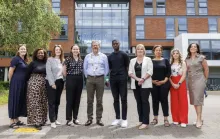From public space transformations that support social interaction and informal learning, to buildings designed as healthy learning spaces, to accessible pedestrian and cyclist friendly pathways, UBC’s campus environments—both built and natural—play an important role in facilitating physical, mental, social and ecological wellbeing for all community members.
UBC has several plans that guide the physical planning of the University to ensure that we are designing and building complete campuses that are diverse, vibrant, lively and healthy. Through our campus planning, we are creating places that:
Promote physical activity;
Enable social connections;
Improve productivity, learning and overall health;
Reduce financial stress of housing and transportation costs;
Foster equity by creating a barrier-free campus.
Learning spaces are a key aspect of our approach to campus planning and are crucial to UBC's core mission of teaching, learning, research and engagement. The Learning Spaces Team collaborates to improve teaching and learning in the classroom through initiatives to expand technological capability in classrooms and lecture halls, improve scheduling and utilize rooms. UBC Collegia on the Vancouver and Okanagan campuses designed as a “home away from home” for commuter students, provide opportunities to connect and build community, while our commitment to embracing innovative policies and procedures in our building practices are helping to define what green buildings and communities can look like.
Strategies
Targets were determined through extensive community engagement and inform actions in this wellbeing priority area. View the long-range description of success and why it matters here.
Learn More
For more data, stories, and more, explore the sections below.



